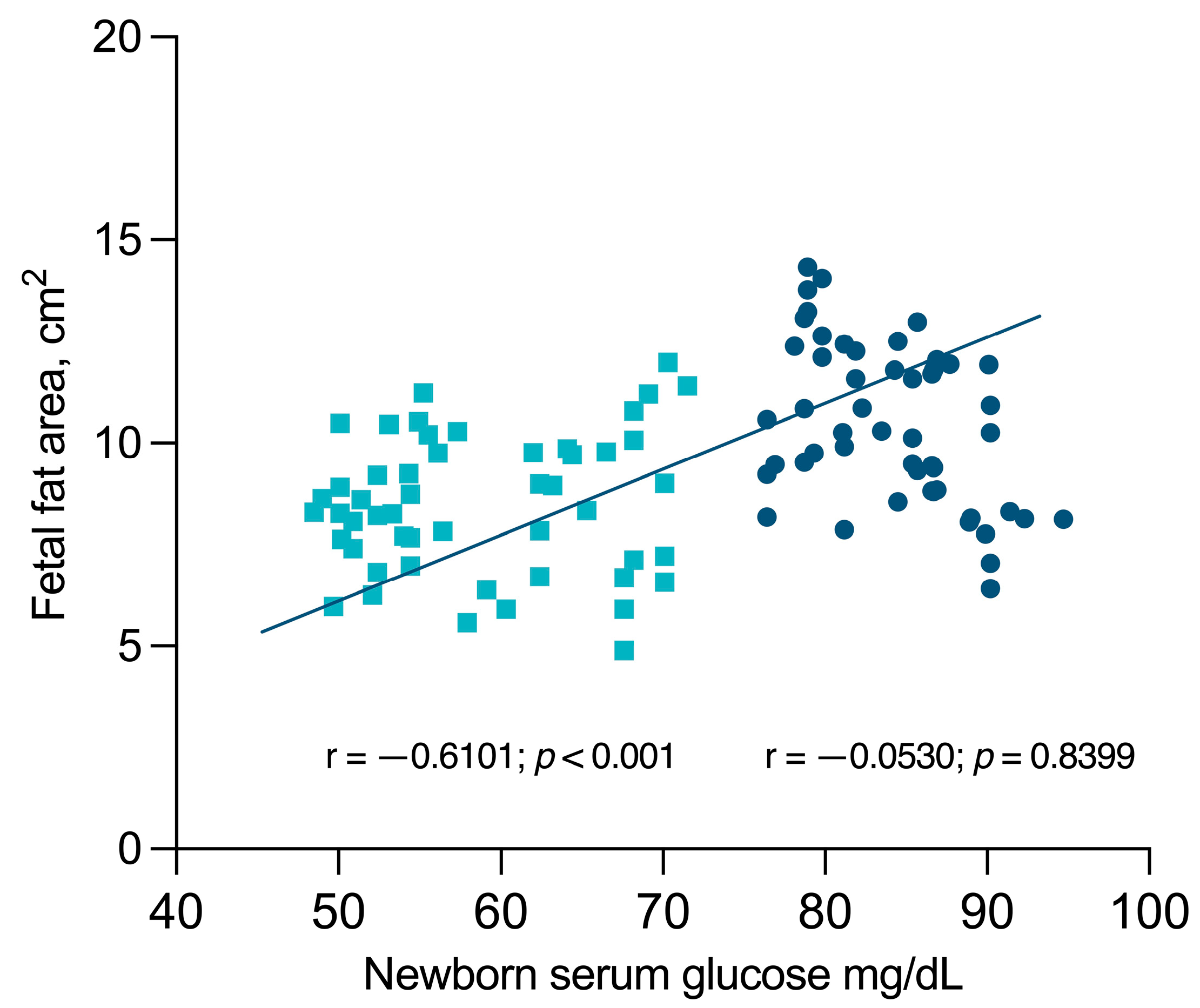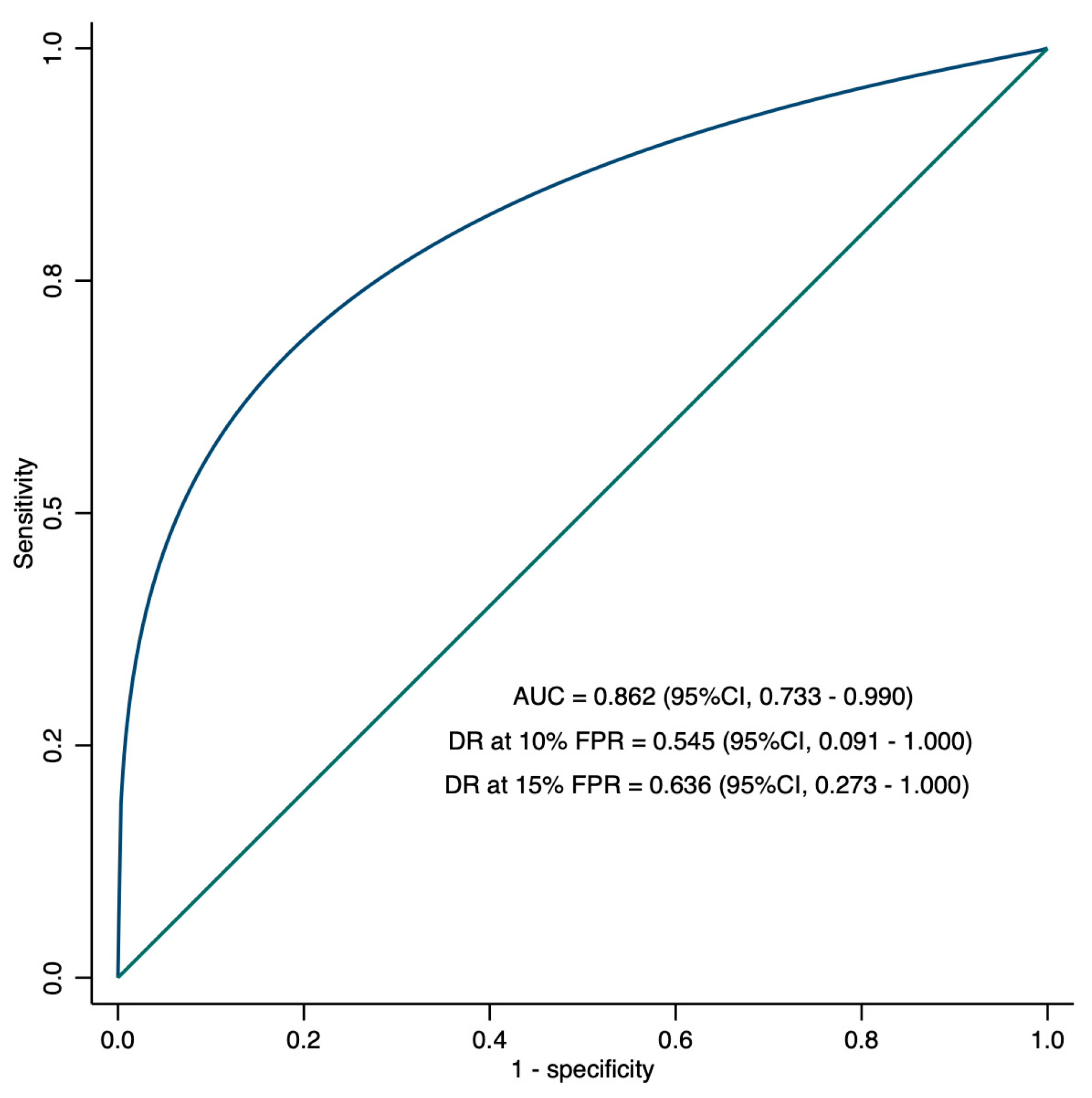Impact of Protease Inhibitor-Based Highly Active Antiretroviral Therapy on Fetal Subcutaneous Fat Tissue in HIV-Pregnant Women in a Middle-Income Country
Abstract
1. Introduction
2. Materials and Methods
2.1. Study Design and Participants
2.2. Ultrasound Fetometry and Fat Mass Area Assessment
2.3. Outcomes
2.4. Statistical Analysis
3. Results
3.1. Description and Characteristics of the Study Groups
3.2. Association between PI-HAART and Fetal SFT
3.3. Association between Fetal SFT and Serum Glucose in the Newborn
4. Discussion
4.1. Main Findings
4.2. Comparison with Existing Literature
4.3. Strengths and Limitations of the Study
4.4. Clinical Interpretation
5. Conclusions
Supplementary Materials
Author Contributions
Funding
Institutional Review Board Statement
Informed Consent Statement
Data Availability Statement
Conflicts of Interest
References
- Trindade, L.N.M.; Nogueira, L.M.V.; Rodrigues, I.L.A.; Ferreira, A.M.R.; Corrêa, G.M.; Andrade, N.C.O. HIV infection in pregnant women and its challenges for the prenatal care. Rev. Bras. Enferm. 2021, 74, e20190784. [Google Scholar] [CrossRef]
- Drake, A.L.; Wagner, A.; Richardson, B.; John-Stewart, G. Incident HIV during pregnancy and postpartum and risk of mother-to-child HIV transmission: A systematic review and meta-analysis. PLoS Med. 2014, 11, e1001608. [Google Scholar] [CrossRef]
- Johnson, L.F.; Mutemaringa, T.; Heekes, A.; Boulle, A. Effect of HIV Infection and Antiretroviral Treatment on Pregnancy Rates in the Western Cape Province of South Africa. J. Infect. Dis. 2020, 221, 1953–1962. [Google Scholar] [CrossRef]
- Mofenson, L.M.; Baggaley, R.C.; Mameletzis, I. Tenofovir disoproxil fumarate safety for women and their infants during pregnancy and breastfeeding. Aids 2017, 31, 213–232. [Google Scholar] [CrossRef]
- Koss, C.A.; Natureeba, P.; Kwarisiima, D.; Ogena, M.; Clark, T.D.; Olwoch, P.; Cohan, D.; Okiring, J.; Charlebois, E.D.; Kamya, M.R.; et al. Viral Suppression and Retention in Care up to 5 Years after Initiation of Lifelong ART during Pregnancy (Option B+) in Rural Uganda. J. Acquir. Immune Defic. Syndr. 2017, 74, 279–284. [Google Scholar] [CrossRef]
- Debroy, P.; Lake, J.E.; Moser, C.; Olefsky, M.; Erlandson, K.M.; Scherzinger, A.; Stein, J.H.; Currier, J.S.; Brown, T.T.; McComsey, G.A. Antiretroviral Therapy Initiation Is Associated with Decreased Visceral and Subcutaneous Adipose Tissue Density in People Living with Human Immunodeficiency Virus. Clin. Infect. Dis. 2021, 72, 979–986. [Google Scholar] [CrossRef]
- Koethe, J.R.; Lagathu, C.; Lake, J.E.; Domingo, P.; Calmy, A.; Falutz, J.; Brown, T.T.; Capeau, J. HIV and antiretroviral therapy-related fat alterations. Nat. Rev. Dis. Primers 2020, 6, 48. [Google Scholar] [CrossRef]
- Tshamala, H.K.; Aketi, L.; Tshibassu, P.M.; Ekila, M.B.; Mafuta, E.M.; Kayembe, P.K.; Aloni, M.N.; Shiku, J.D. The Lipodystrophy Syndrome in HIV-Infected Children under Antiretroviral Therapy: A First Report from the Central Africa. Int. J. Pediatr. 2019, 2019, 7013758. [Google Scholar] [CrossRef]
- Lake, J.E.; Currier, J.S. Metabolic disease in HIV infection. Lancet Infect. Dis. 2013, 13, 964–975. [Google Scholar] [CrossRef]
- Martínez, E.; Garcia-Viejo, M.A.; Blanch, L.; Gatell, J.M. Lipodystrophy syndrome in patients with HIV infection: Quality of life issues. Drug Saf. 2001, 24, 157–166. [Google Scholar] [CrossRef]
- Hirsch, H.H.; Battegay, M. Lipodystrophy syndrome by HAART in HIV-infected patients: Manifestation, mechanisms and management. Infection 2002, 30, 293–298. [Google Scholar] [CrossRef]
- Shinar, S.; Agrawal, S.; Ryu, M.; Walmsley, S.; Serghides, L.; Yudin, M.H.; Murphy, K.E. Perinatal outcomes in women living with HIV-1 and receiving antiretroviral therapy-a systematic review and meta-analysis. Acta Obstet. Gynecol. Scand. 2022, 101, 168–182. [Google Scholar] [CrossRef]
- Chilaka, V.N.; Konje, J.C. HIV in pregnancy—An update. Eur. J. Obstet. Gynecol. Reprod. Biol. 2021, 256, 484–491. [Google Scholar] [CrossRef]
- Costa, J.M.; Torres, T.S.; Coelho, L.E.; Luz, P.M. Adherence to antiretroviral therapy for HIV/AIDS in Latin America and the Caribbean: Systematic review and meta-analysis. J. Int. AIDS Soc. 2018, 21. [Google Scholar] [CrossRef]
- Hernanz-Lobo, A.; Ruiz Saez, B.; Carrasco García, I.; Mino-Leon, G.; Juárez, J.; Pavía Ruz, N.; Estripeaut, D.; Pérez, M.; Erazo, K.; Castaneda Villatoro, L.G.; et al. New diagnosis of mother-to-child transmission of HIV in 8 Latin-American countries during 2018. BMC Infect. Dis. 2022, 22, 347. [Google Scholar] [CrossRef]
- México, C.S.d.S. Guía de Manejo Antirretroviral de las Personas con VIH. Available online: https://www.gob.mx/cms/uploads/attachment/file/712164/Gu_a_TAR_fe_erratas_2022.pdf (accessed on 30 October 2023).
- Saag, M.S.; Gandhi, R.T.; Hoy, J.F.; Landovitz, R.J.; Thompson, M.A.; Sax, P.E.; Smith, D.M.; Benson, C.A.; Buchbinder, S.P.; Del Rio, C.; et al. Antiretroviral Drugs for Treatment and Prevention of HIV Infection in Adults: 2020 Recommendations of the International Antiviral Society-USA Panel. JAMA 2020, 324, 1651–1669. [Google Scholar] [CrossRef]
- Mulligan, K.; Anastos, K.; Justman, J.; Freeman, R.; Wichienkuer, P.; Robison, E.; Hessol, N.A. Fat distribution in HIV-infected women in the United States: DEXA substudy in the Women’s Interagency HIV Study. J. Acquir. Immune Defic. Syndr. 2005, 38, 18–22. [Google Scholar] [CrossRef]
- Lu, W.L.; Lee, Y.T.; Sheu, G.T. Metabolic Syndrome Prevalence and Cardiovascular Risk Assessment in HIV-Positive Men with and without Antiretroviral Therapy. Medicina 2021, 57, 578. [Google Scholar] [CrossRef]
- Nsagha, D.S.; Assob, J.C.; Njunda, A.L.; Tanue, E.A.; Kibu, O.D.; Ayima, C.W.; Ngowe, M.N. Risk Factors of Cardiovascular Diseases in HIV/AIDS Patients on HAART. Open AIDS J. 2015, 9, 51–59. [Google Scholar] [CrossRef]
- Van Wijk, J.P.; Cabezas, M.C. Hypertriglyceridemia, Metabolic Syndrome, and Cardiovascular Disease in HIV-Infected Patients: Effects of Antiretroviral Therapy and Adipose Tissue Distribution. Int. J. Vasc. Med. 2012, 2012, 201027. [Google Scholar] [CrossRef][Green Version]
- Han, W.M.; Kerr, S.J.; Avihingsanon, A.; Boettiger, D.C. Weight change with integrase strand transfer inhibitors among virally suppressed Thai people living with HIV. J. Antimicrob. Chemother. 2022, 77, 3242–3247. [Google Scholar] [CrossRef]
- Fuller, T.; Fragoso da Silveira Gouvêa, M.I.; Benamor Teixeira, M.L.; Ferreira Medeiros, A.; Amorim da Silva, P.; Medeiros Braga, C.; Constan Werneck Sant’anna, M.; de Mattos Salgueiro, M.; da Silveira Bressan, C.; Mendes-Silva, W.; et al. Real-world experience with weight gain among pregnant women living with HIV who are using integrase inhibitors. HIV Med. 2023, 24, 301–310. [Google Scholar] [CrossRef]
- Dontsova, V.; Mohan, H.; Blanco, C.; Jao, J.; Greene, N.D.E.; Copp, A.J.; Zash, R.; Serghides, L. Metabolic implications and safety of dolutegravir use in pregnancy. Lancet HIV 2023, 10, e606–e616. [Google Scholar] [CrossRef]
- Brüggen, M.C.; Stingl, G. Subcutaneous white adipose tissue: The deepest layer of the cutaneous immune barrier. J. Dtsch. Dermatol. Ges. 2020, 18, 1225–1227. [Google Scholar] [CrossRef]
- Rosen, E.D.; Spiegelman, B.M. What we talk about when we talk about fat. Cell 2014, 156, 20–44. [Google Scholar] [CrossRef]
- Tran, T.T.; Yamamoto, Y.; Gesta, S.; Kahn, C.R. Beneficial effects of subcutaneous fat transplantation on metabolism. Cell Metab. 2008, 7, 410–420. [Google Scholar] [CrossRef]
- Nakano, Y. Adult-Onset Diseases in Low Birth Weight Infants: Association with Adipose Tissue Maldevelopment. J. Atheroscler. Thromb. 2020, 27, 397–405. [Google Scholar] [CrossRef]



| Control n = 17 Mean (Ranges) | HIV Positive n = 17 Mean (Ranges) | p Value | |
|---|---|---|---|
| Maternal age (year) | 33 (27–36) | 31 (29–33) | 0.407 |
| Gestational age at screening (weeks) | 36.3 (36.1–36.4) | 36.2 (36.1–36.3) | 0.636 |
| Gestational BMI (Kg/m2) | 27.53 (26.02–29.38) | 25.78 (24.30–29.38) | 0.221 |
| Maternal cholesterol (mg/dL) | 261.05 (234–302) | 253.11 (204–290) | 0.758 |
| Maternal triglycerides (mg/dL) | 221.76 (145–310) | 230.82 (167–301) | 0.362 |
| Fetal weight by ultrasound (g) | 2809 (2743–2967) | 2712 (2654–2799) | 0.105 |
| Newborn weight (g) | 2890 (2780–2990) | 2832 (2745–2940) | 0.191 |
| Abdominal circumference at birth (cm) | 31.5 (30–32) | 32.5 (32–33) | 0.015 |
| Gestational age at birth (weeks) | 38.5 (38.3–39) | 38.2 (38.1–38.4) | 0.261 |
| Preeclampsia | 0 | 1 (5.88%) | 0.310 |
| Fetal growth restriction | 0 | 1 (5.88%) | 0.310 |
| Apgar 1 min | 8 (8–9) | 8 (8–9) | 0.379 |
| Apgar 5 min | 8 (8–9) | 8 (8–9) | 0.558 |
| Maternal serum glucose at birth (mg/dL) | 85.4 (79.8–86.7) | 85.3 (79.2–90) | 0.783 |
| Newborn serum glucose (mg/dL) | 65.7 (62.1–70.3) | 56.1 (52.4–65.3) | 0.007 |
| Newborn cholesterol (mg/dL) | 152.82 (122–178) | 151.47 (110–189) | 0.373 |
| Newborn HDL cholesterol (mg/dL) | 51.23 (42–60) | 51.64 (34–62) | 0.129 |
| Newborn LDL cholesterol (mg/dL) | 70.58 (63–78) | 71.88 (62–79) | 0.073 |
| Newborn triglycerides (mg/dL) | 135.41 (120–160) | 137.94 (119–167) | 0.910 |
| Control cm2, Median (IQR) | HIV Positive cm2, Median (IQR) | p Value | |
|---|---|---|---|
| HUMERUS | |||
| Proximal third-middle union | 6.85 (5.45–7.98) | 5.6 (5.19–6.06) | 0.047 |
| Middle | 6.26 (5.79–7.1) | 5.34 (5.08–5.81) | 0.018 |
| Distal third-middle | 5.92 (5.49–6.67) | 5.1 (4.26–5.63) | 0.007 |
| FEMUR | |||
| Proximal third-middle union | 11.94 (10.94–12.52) | 9.22 (8.64–10.09) | 0.001 |
| Middle | 9.76 (8.19–11.81) | 8.22 (7.24–9.73) | 0.016 |
| Distal third-middle | 9.51 (8.82–10.32) | 7.84 (6.83–8.97) | 0.005 |
| Coefficient | 95%CI | p-Value | |
|---|---|---|---|
| HUMERUS | |||
| Proximal third-middle union | 0.955 | −1.042–2.954 | 0.348 |
| Middle | −1.690 | −4.324–0.944 | 0.209 |
| Distal third-middle | −1.704 | −4.311–0.904 | 0.200 |
| FEMUR | |||
| Proximal third-middle union | −2.588 | −5.506–0.329 | 0.042 |
| Middle | 0.509 | −0.234–3.254 | 0.090 |
| Distal third-middle | 0.897 | −0.693–2.488 | 0.269 |
| Fetal weight | −0.302 | −0.106–4.624 | 0.438 |
| Newborn weight | −0.163 | −0.044–0.012 | 0.254 |
| Newborn abdominal circumference | 0.456 | −0.561–1.472 | 0.380 |
| Newborn serum glucose | −1.277 | −3.055–0.058 | 0.045 |
| Maternal BMI | 1.794 | −1.305–4.895 | 0.257 |
| Maternal serum glucose | 0.019 | −0.325–0.364 | 0.911 |
Disclaimer/Publisher’s Note: The statements, opinions and data contained in all publications are solely those of the individual author(s) and contributor(s) and not of MDPI and/or the editor(s). MDPI and/or the editor(s) disclaim responsibility for any injury to people or property resulting from any ideas, methods, instructions or products referred to in the content. |
© 2023 by the authors. Licensee MDPI, Basel, Switzerland. This article is an open access article distributed under the terms and conditions of the Creative Commons Attribution (CC BY) license (https://creativecommons.org/licenses/by/4.0/).
Share and Cite
Borboa-Olivares, H.; Estrada-Gutierrez, G.; Martinez-Portilla, R.J.; Espino-y-Sosa, S.; Flores-Pliego, A.; Espejel-Nuñez, A.; Camacho-Arroyo, I.; Solis-Paredes, J.M.; Villafan-Bernal, J.R.; Torres-Torres, J. Impact of Protease Inhibitor-Based Highly Active Antiretroviral Therapy on Fetal Subcutaneous Fat Tissue in HIV-Pregnant Women in a Middle-Income Country. Viruses 2024, 16, 10. https://doi.org/10.3390/v16010010
Borboa-Olivares H, Estrada-Gutierrez G, Martinez-Portilla RJ, Espino-y-Sosa S, Flores-Pliego A, Espejel-Nuñez A, Camacho-Arroyo I, Solis-Paredes JM, Villafan-Bernal JR, Torres-Torres J. Impact of Protease Inhibitor-Based Highly Active Antiretroviral Therapy on Fetal Subcutaneous Fat Tissue in HIV-Pregnant Women in a Middle-Income Country. Viruses. 2024; 16(1):10. https://doi.org/10.3390/v16010010
Chicago/Turabian StyleBorboa-Olivares, Hector, Guadalupe Estrada-Gutierrez, Raigam Jafet Martinez-Portilla, Salvador Espino-y-Sosa, Arturo Flores-Pliego, Aurora Espejel-Nuñez, Ignacio Camacho-Arroyo, Juan Mario Solis-Paredes, Jose Rafael Villafan-Bernal, and Johnatan Torres-Torres. 2024. "Impact of Protease Inhibitor-Based Highly Active Antiretroviral Therapy on Fetal Subcutaneous Fat Tissue in HIV-Pregnant Women in a Middle-Income Country" Viruses 16, no. 1: 10. https://doi.org/10.3390/v16010010
APA StyleBorboa-Olivares, H., Estrada-Gutierrez, G., Martinez-Portilla, R. J., Espino-y-Sosa, S., Flores-Pliego, A., Espejel-Nuñez, A., Camacho-Arroyo, I., Solis-Paredes, J. M., Villafan-Bernal, J. R., & Torres-Torres, J. (2024). Impact of Protease Inhibitor-Based Highly Active Antiretroviral Therapy on Fetal Subcutaneous Fat Tissue in HIV-Pregnant Women in a Middle-Income Country. Viruses, 16(1), 10. https://doi.org/10.3390/v16010010














